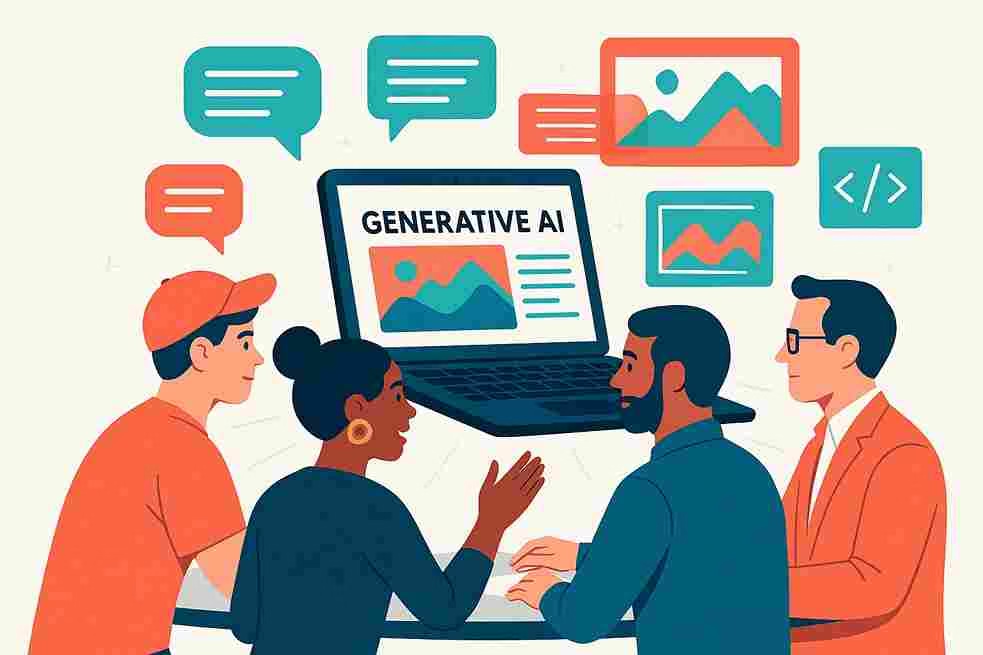Mastering Generative AI in 2025: Your Complete Guide to Tools, Skills, and Thriving in the AI Revolution

Mastering Generative AI in 2025: Your Complete Guide to Tools, Skills, and Thriving in the AI Revolution
May 24, 2025
The AI Revolution Is Here—Are You Ready?
Imagine crafting a viral video script, designing a stunning digital artwork, or coding an app—all with a few keystrokes, powered by artificial intelligence. In 2025, generative AI is making this a reality, transforming industries from entertainment to healthcare. With tools like ChatGPT, DALL·E 3, and GitHub Copilot, anyone can harness AI to create, innovate, and excel. But here’s the catch: as demand for AI skills skyrockets—job postings are up 65% year-over-year (LinkedIn, 2025)—standing out requires a strategic approach. This guide, crafted by BytesWall, is your roadmap to mastering generative AI, packed with tools, skills, and career strategies to thrive in the AI revolution. For more tech career tips, explore our innovation insights.
Step 1: Build a Strong Foundation in Generative AI
Before diving into code or tools, you need to understand what makes generative AI tick. Think of it as learning the grammar of a new language—one that lets machines create text, images, and code from scratch.
Understanding the Basics
Generative AI uses models like transformers (the tech behind ChatGPT) and diffusion systems (powering Stable Diffusion) to generate content. Key concepts include:
- Neural Networks: The “brain” of AI, processing data in layers.
- Large Language Models (LLMs): Trained on massive datasets to produce human-like text.
- Generative Adversarial Networks (GANs): Two models competing to create realistic outputs, like images.
Start with beginner-friendly resources to grasp these ideas without feeling overwhelmed.
Recommended Learning Resources
Top Free Resources
- Coursera: “Introduction to Generative AI” by Google Cloud (free audit, ~10 hours). Covers LLMs and diffusion models.
- Fast.ai: “Practical Deep Learning for Coders” (free, ~20 hours). Includes generative AI basics.
- YouTube: 3Blue1Brown’s neural network videos (free, ~2 hours). Visualizes complex concepts like backpropagation.
- Hugging Face: Free tutorials on LLMs and model deployment.
Action Plan (Weeks 1–3): Spend 10–15 hours per week. Complete Coursera’s introductory course, watch 5–10 YouTube videos, and take notes on terms like GANs, VAEs, and transformers. Quiz yourself on key concepts to solidify understanding.
Step 2: Get Hands-On with Generative AI Tools
Theory is great, but generative AI shines when you start building. Hands-on projects help you understand how AI models work and make your portfolio irresistible to employers.
Essential Tools to Master
These tools are the backbone of generative AI in 2025, offering accessible ways to create text, images, and code:
Top Generative AI Tools
- Hugging Face: A free, open-source platform with thousands of pre-trained LLMs and diffusion models. Perfect for text and image generation.
- Stable Diffusion: Generates high-quality images from text prompts. Free with local setup or ~$10/month via cloud platforms like Runway.
- GitHub Copilot: AI-powered code completion tool for Python, JavaScript, and more ($10/month).
- Midjourney: Premium image generation tool for professional-grade art ($30/month).
Programming Frameworks and Languages
Python is the go-to language for AI. Pair it with these frameworks:
- PyTorch: Flexible and beginner-friendly for prototyping generative models.
- TensorFlow: Robust for scaling AI projects to production.
If you’re new to Python, start with free tutorials on Codecademy (10 hours to learn basics).
Project Ideas to Build Your Skills
Try these beginner-friendly projects to gain practical experience:
- Chatbot: Use Hugging Face to build a text-based AI assistant that answers FAQs.
- Image Generator: Create a tool with Stable Diffusion to turn text prompts into artwork.
- Code Helper: Use GitHub Copilot to automate repetitive coding tasks, like generating HTML templates.
Action Plan (Weeks 4–9): Dedicate 15–20 hours per week. Set up Hugging Face and Stable Diffusion, then complete 3–4 projects. Host them on GitHub to showcase your work. Use Kaggle for free datasets and tutorials to guide your projects.
Step 3: Develop In-Demand Skills for AI Careers
To stand out in the competitive AI job market, you need a mix of technical expertise and soft skills to translate complex ideas into real-world solutions.
Core Technical Skills
Focus on these areas to build a strong foundation:
- Machine Learning: Understand supervised and unsupervised learning. Take Coursera’s “Machine Learning” by Andrew Ng (free audit, ~60 hours).
- Natural Language Processing (NLP): Critical for text-based AI like chatbots. Try DeepLearning.AI’s “Natural Language Processing Specialization” ($49, ~40 hours).
- Data Preprocessing: Learn to clean and format datasets for AI training. Kaggle’s free “Data Cleaning” course (~5 hours) is a great start.
- Model Fine-Tuning: Customize pre-trained models for specific tasks using Hugging Face’s APIs.
Soft Skills for Success
AI isn’t just about code—it’s about collaboration and communication:
- Problem-Solving: Break down complex AI challenges into actionable steps.
- Communication: Explain AI concepts to non-technical stakeholders. Practice presenting your projects to friends or online forums.
- Adaptability: Stay current with AI’s rapid evolution by following blogs like Towards Data Science.
Action Plan (Weeks 10–16): Spend 15–20 hours per week. Complete two advanced courses (e.g., NLP and machine learning), join an AI community like r/MachineLearning, and practice explaining your projects in 2-minute pitches. Attend a virtual AI meetup to network.
Step 4: Launch Your Career in Generative AI
The generative AI job market is red-hot, with roles spanning research, engineering, and creative applications. Here’s how to position yourself for success.
Top Career Paths
In-Demand AI Roles
- AI Research Scientist: Innovate new generative models ($120K–$200K/year, Glassdoor 2025). Requires a PhD or strong research portfolio.
- Machine Learning Engineer: Build and deploy AI systems ($100K–$150K/year). Needs coding and cloud skills.
- AI Content Specialist: Create AI-driven content for marketing or media ($80K–$120K/year). Ideal for creative techies.
- AI Ethics Consultant: Address bias and fairness in AI ($90K–$140K/year). Growing demand for responsible AI.
Building Your Career Toolkit
To land your dream job, focus on these steps:
- Portfolio: Host 3–5 projects on GitHub, like a chatbot or image generator, with clear documentation.
- Certifications: Earn credentials like Google’s “Professional Machine Learning Engineer” ($200 exam) or AWS’s “AI Practitioner” ($100 exam).
- Networking: Connect with AI professionals on LinkedIn or at conferences like NeurIPS (virtual tickets ~$100). Share your projects on X with #GenerativeAI2025.
- Job Applications: Apply to roles via Indeed or LinkedIn. Tailor your resume with keywords like “generative AI” and “NLP.”
Action Plan (Weeks 17–20): Spend 10–15 hours per week. Finalize your portfolio, earn one certification, and apply to 10–15 jobs. Attend one AI event and follow up with 5 new contacts.
Your 90-Day Roadmap to AI Mastery
Ready to dive in? This 90-day plan breaks your journey into manageable steps, balancing learning, building, and networking.
90-Day Study Plan
- Month 1: Foundations
- Week 1–2: Complete Coursera’s “Introduction to Generative AI” and watch 3Blue1Brown videos.
- Week 3–4: Finish Fast.ai’s “Practical Deep Learning” and create an AI glossary.
- Month 2: Hands-On Projects
- Week 5–6: Build a text generator with Hugging Face.
- Week 7–8: Create an image generator with Stable Diffusion on Kaggle.
- Month 3: Advanced Skills and Career Prep
- Week 9–10: Complete Coursera’s “Machine Learning” course.
- Week 11–12: Join r/MachineLearning and share a project.
- Week 13–14: Earn a certification (e.g., Google’s ML Engineer).
- Week 15–16: Build a GitHub portfolio and apply to 10 jobs.
Pro Tip: Study 15–20 hours per week and track progress with a journal or app like Notion. Celebrate milestones (e.g., finishing a project) to stay motivated.
Overcoming Common Challenges
Learning generative AI can feel daunting, but these tips address common hurdles:
Solutions to AI Learning Obstacles
- Feeling Overwhelmed: Break learning into 1-hour daily sessions and focus on one topic at a time (e.g., LLMs before GANs).
- Lack of Coding Experience: Start with Codecademy’s free Python course (10 hours) before diving into PyTorch.
- Budget Constraints: Use free tools like Hugging Face and Kaggle, and audit courses on Coursera.
- Staying Motivated: Join an AI study group on Discord or Reddit to share progress and get feedback.
Action Plan: Identify your biggest challenge and tackle it with one of these solutions. Check in weekly to assess progress.
Join the AI Revolution with BytesWall
Generative AI is your ticket to a future-proof career, and BytesWall is here to guide you every step of the way. Whether you’re building your first chatbot or aiming for a six-figure AI job, our tech insights and community have you covered. Connect with us at [contact@byteswall.com] to share your AI journey, collaborate on content, or get personalized advice. Dive deeper into tech career strategies with our skills guide.
Shape the Future of AI
What’s your generative AI goal for 2025? Share your learning plan or project ideas in the comments below with #GenerativeAI2025!
Unlock the future of tech with more guides at BytesWall.com—your source for innovation!




Priya M.
This guide is a game-changer! Just built my first chatbot with Hugging Face—feeling unstoppable!
Arjun K.
The 90-day plan is perfect. Already halfway through my Stable Diffusion project!